The Easter cactus is available in many different colors and, as the name suggests, often blooms just in time for Easter. We give tips on how to stimulate flowering.
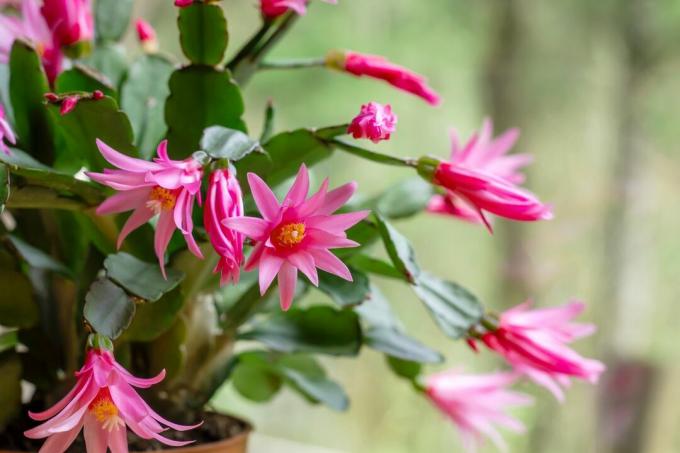
Like many cacti, the Easter cactus is a fairly easy-care plant. If the winter break is observed, you can enjoy the colorful flowers in spring. Here we show you what needs to be considered when it comes to care and location selection.
contents
- Easter cactus: flowering, origin and properties
- The most beautiful types and varieties
- Easter cactus: location, soil and co.
-
Easter cactus care: This is important to note
- Water and fertilize
- Cut Easter cactus
- Repot Easter cactus
- The Easter cactus does not bloom: what to do?
- Propagating Easter cactus
- Is the Easter cactus poisonous?
Easter cactus: flowering, origin and properties
At the Easter cactus (Hatiora x grasseri) are hybrids of two species of the genus Hatiora from the cactus family (Cactaceae), viz Hatiora rosea
and Hatiora gaertneri. The parents can also be found commercially as Easter cacti. Both species are widespread in southern Brazil and grow there in the higher lying cloud forests perched on trees or other plants. The shoots of the Easter cactus are succulent and divided into flat sections that first appear red and later turn green. With increasing age, the shoots hang over the edge of the pot. The Easter cactus is therefore also a real eye-catcher in the hanging basket. The Easter cactus flowers in spring between March and April. The bell-shaped flowers sit at the end of the shoots and can take on a wide variety of colors - from red to orange and yellow to pink or white. A winter dormant phase, in which the formation of flowers is stimulated, is decisive for the blooming splendor at Easter.
The most beautiful types and varieties
In addition to the widespread hybrids, the two parent species are sometimes also used Hatiora rosea and Hatiora gaertneri known as Easter cacti.
- Hatiora rosea: This species has pink flowers, as the name suggests. In Brazil, where Hatiora rosea native, it is already considered endangered. There the plant grows at altitudes of up to 2000 meters.
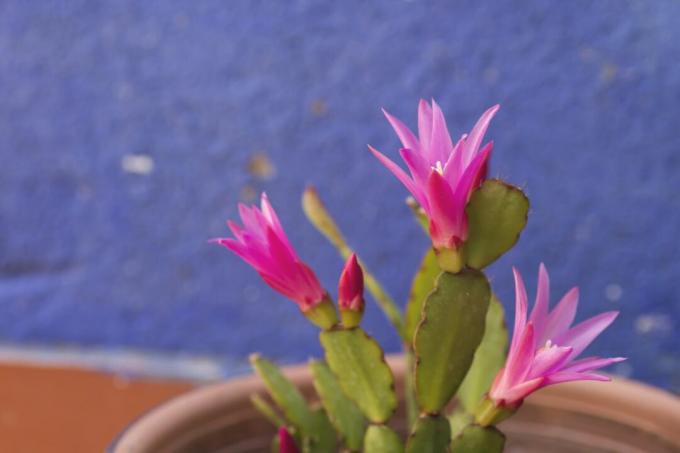
- Hatiora gaertneri: In contrast to Hatiora rosea owns Hatiora gaertneri bright red flowers. The shoots hang down, which is why Easter cacti also cut a fine figure in traffic light pots. This species is also on the Red List and is considered endangered.

- Hatiora x grasseri: The hybrids of the above two species are called Hatiora x grasseri. The commercially available Easter cacti are mostly these hybrids. In addition to red and pink, they are also available in many other colors.
Easter cactus: location, soil and co.
Choose a spot for the Easter cactus that gets light but not full sun. If the sun is too strong, the shoots can turn red. In the growing season between March and October, the temperature should be between 16 and 24 °C. If it doesn't get colder than 10 °C at night in summer, you can easily put the Easter cactus outside. Here, too, a location should be chosen that is protected from the blazing sun. In addition, the Easter cactus needs increased humidity, which can be achieved, for example, by occasionally spraying it with water.
The Easter cactus also likes it bright in winter, but the temperature has to be lower now so that flowers are created for the coming spring. During the winter months you should give the Easter cactus a rest period in which the Care measures such as fertilizing and watering can be largely stopped and the temperature reduced to around 10 °C is lowered. After about six weeks of winter break, the temperature can then slowly be increased to 20 °C. The Easter cactus reacts very sensitively to a change of location during this time and should preferably not be moved or rotated.

A loose, well-aerated substrate with a slightly acidic pH value is suitable as a substrate. A suitable soil can be easily made by yourself. To do this, mix two parts of peat-free potting soil with one part of quartz sand. For the base, it is best to use high-quality soil such as ours Plantura organic potting soil. With its pH value of 6.1 to 6.9, it is in the optimal range for the Easter cactus and contains important nutrients that the Easter cactus needs to grow initially. In addition, the soil is particularly loose and structurally stable due to the expanded clay it contains and does not require any peat at all.
Tip: A layer of potsherds or stones on the bottom of the pot is very important to avoid waterlogging.
Easter cactus care: This is important to note
If you consider a few aspects, Easter cactus care is not particularly complex. For flowering, however, it requires a somewhat more special approach. A six to eight week dormant period is important to allow the Easter cactus to develop blooms in the spring. Even after flowering, another six-week rest period is prescribed, during which less watering and no fertilization is done.
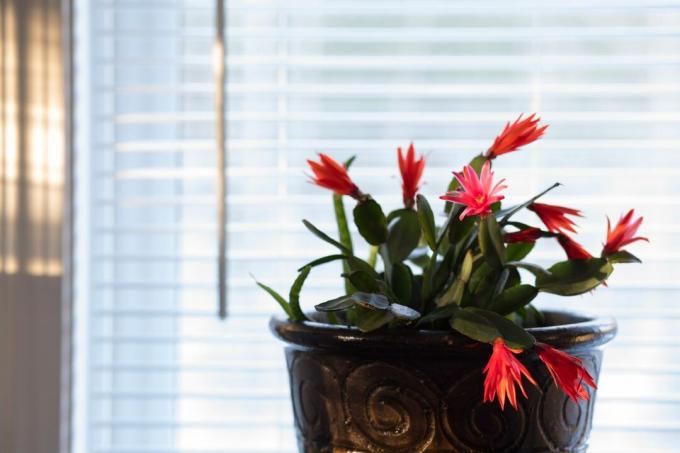
Water and fertilize
The Easter cactus does not need a lot of water, nor does it have a high nutrient requirement. It is best to water it in spring and summer as soon as the substrate has dried on the surface. Avoid complete drying out of the root ball as well as waterlogging. Excess irrigation water should be removed about ten minutes after watering. Room-warm and lime-free water is ideal. Also spray the Easter cactus regularly with lime-free water, as it needs a slightly higher humidity. In winter, watering can be done less frequently, especially during the resting phase at low temperatures, the Easter cactus does not need a lot of water. Therefore, only water enough during the resting phase that the substrate does not dry out completely.
A supply of nutrients is only necessary in the summer, from around April to October. At this time, you should give the Easter cactus a half-strength green plant fertilizer about every three weeks. For example, our is suitable for this Plantura organic indoor and green plant fertilizer, which you can simply mix into the irrigation water. In addition to important nutrients, our primarily organic fertilizer also contains microorganisms that promote root growth. Its production conserves resources and thus also our environment.
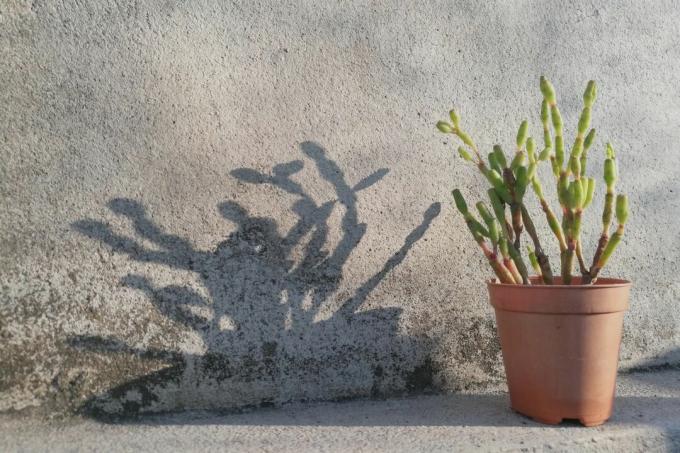
Cut Easter cactus
It is not necessary to cut the Easter cactus. However, if it has become too large, you can cut off individual shoots at the desired location with a sharp knife. These are also useful for propagating the Easter cactus. The cut should be done after the flowering period, so that the flowering is not affected.
Repot Easter cactus
If the old pot has become too small, you should repot the Easter cactus. Again, this is best done after flowering. Place a drainage layer of potsherds, gravel or expanded clay on the bottom of the pot and plant the Easter cactus in a suitable, permeable substrate. Repotting is usually necessary every two to three years. In the meantime, it is sufficient to remove only the top layer of substrate and fill in with new soil.
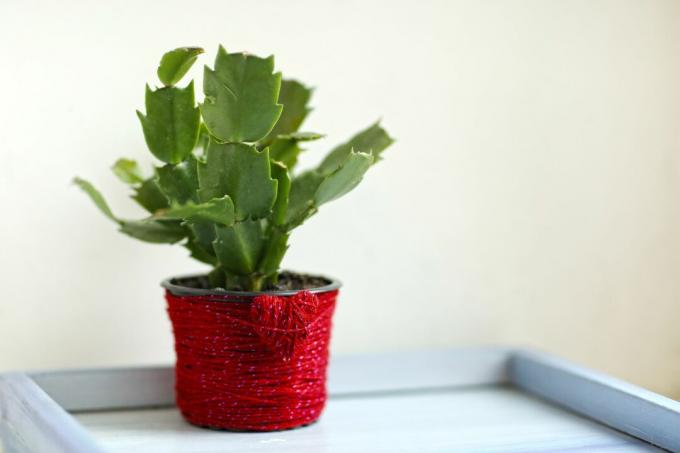
The Easter cactus does not bloom: what to do?
Is your Easter cactus not blooming? This can have the following reasons:
- Missing rest period: The most common reason for a lack of flowering is probably incorrect overwintering. The Easter cactus needs a bright but cool place with temperatures of around 10 °C for the planting of the flower buds. The resting phase should last four to eight weeks and the location should not be changed during this time. When the first buds appear, you can slowly increase the temperature.
- Incorrect care: Even if the hibernation is very important for the formation of flowers, it is still possible that the Easter cactus does not form any flowers due to a lack of nutrients or too little space. Therefore, check whether the pot is big enough and the substrate is not too wet. During the growth phase, the Easter cactus also needs regular nutrient additions.
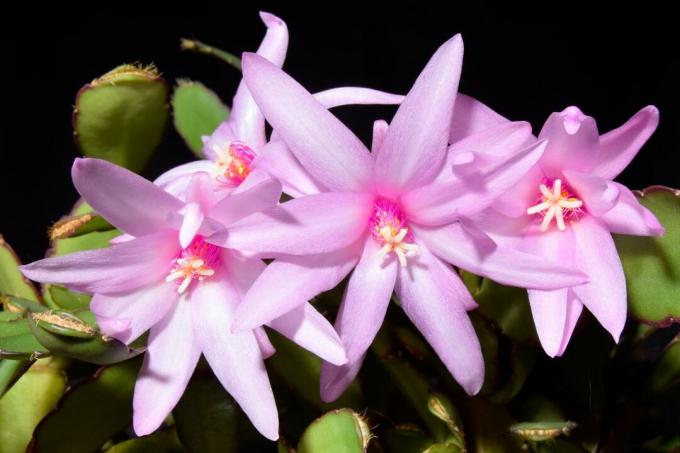
Propagating Easter cactus
To multiply the Easter cactus, you can use cuttings or seeds.
cuttings: Using a sharp knife, cut off a shoot about 10 cm long from the plant. Let it air dry for three days and stick it into the substrate with the interface. A mixture of two parts potting soil and one part quartz sand is well suited. Moisten the soil and choose a light and warm place for the cutting. Temperatures of around 23°C are ideal. Roots are formed after about four weeks.
seeds: Propagation via seeds is also possible. To do this, the Easter cactus flowers must be pollinated. Pollination can be done by hand with a brush or by self-pollination of individual flowers. After fruits are formed, the seeds can be detached and spread on moist substrate. Covering with cling film ensures higher humidity and accelerates growth. Germination takes place in a bright and warm location after about three weeks.

Is the Easter cactus poisonous?
The Easter cactus is not poisonous and can therefore be placed anywhere in the home. Even if it's outside in the summer, you don't have to worry.
The Christmas cactus looks very similar to the Easter cactus. However, as the name suggests, it blossoms at a different time. Here's how to do it Stimulate flowering of the Christmas cactus be able.



